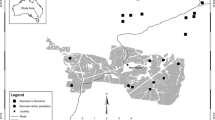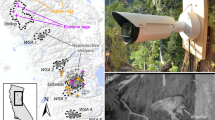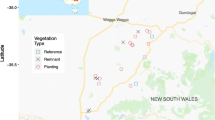Abstract
Size of a forest patch is a useful predictor of density and reproductive success of Neotropical migratory birds in much of eastern North America. Within these forested landscapes, large forest tracts appear to be sources – fragments in which surpluses of offspring are produced and can potentially colonize new fragments including woodlot sinks where reproduction fails to balance adult mortality. Within agricultural landscapes of the midwestern U.S., where forests are severely fragmented, high levels of brood parasitism by brown-headed cowbirds (Molothrus ater) and intense predation on nests generally result in low reproductive success for Neotropical migrants regardless of forest size. In some midwestern U.S. landscapes, however, the variation in reproductive success among forest fragments suggests that `source' habitat could still exist for Neotropical migrants. We used vegetation, fragment and landscape metrics to develop multivariate models that attempt to explain the variation in abundance and reproductive success of Neotropical migrants nesting in an agricultural landscape in northern Indiana, USA. We produced models that reasonably described the pattern of species richness of Neotropical migrants and the abundance of wood thrushes (Hylocichla mustelina) and several other Neotropical migrant species within 14 forest fragments. In contrast, we were unable to produce useful models of the reproductive success of wood thrushes breeding in the same forest fragments. Our results suggest that (1) abundance patterns of Neotropical migrants are probably influenced by both landscape- and fragment-scale factors; (2) multivariate analyses of Neotropical migrant abundance are not useful in modeling the corresponding patterns of reproductive success; and (3) the location of any remaining `source' habitat for Neotropical migrants breeding within agricultural landscapes in North America will be difficult to predict with indirect measures such as vegetation composition or landscape context. As a result, the potential for developing conservation strategies for Neotropical migrants will be limited without labor-intensive, direct measurements of demographic parameters.
Similar content being viewed by others
References
Ambuel, B. and Temple, S.A., 1983. Area-dependent changes in the bird communities and vegetation of southern Wisconsin forests. Ecology 64: 1057–1068.
Askins, R.A., Lynch, J.F. and Greenberg, R. 1990. Population declines in migratory birds in eastern North America. Current Ornithol 7: 1–57.
Blake, J.G., and Karr, J.R. 1987. Breeding birds of isolated woodlots: area and habitat relationships. Ecology 68: 1724–1734.
Brawn, J.D. and Robinson, S.K. 1996. Source-sink population dynamics may complicate the interpretation of long-term census data. Ecology 77: 3–12.
Brittingham, M.C. and Temple, S.A. 1983. Have cowbirds caused forest songbirds to decline? Bioscience 33: 31–35.
Brittingham, M.C. and Temple, S.A. 1996. Vegetation around parasitized and unparasitized nests within deciduous forest. J. Field Ornithol. 67: 406–413.
Burke, D.M. and Nol, E. 1998. Influence of food abundance, nestsite habitat, and forest fragmentation on breeding Ovenbirds. Auk 115: 96–104.
DeGraaf, R.M. and Rappole, J.H. 1995. Neotropical Migratory Birds: Natural History, Distribution, and Population Change. Comstock Publishing Associates, Ithaca, NY.
Donovan, T.M., Thompson III, F.R., Faaborg, J. and Probst, J.R. 1995. Reproductive success of migratory birds in habitat sources and sinks. Cons. Biol. 9: 1380–1395.
Faaborg, J., Brittingham, M.C., Donovan, T.M. and Blake, J.G. 1995. Habitat fragmentation in the temperate zone. In Ecology and Management of Neotropical Migratory Birds: A Synthesis and Review of Critical Issues. pp. 357–380. Edited by T.E. Martin and D.M. Finch. Oxford University Press, New York.
Fauth, P.T. 1997. Effects of forest fragmentation on breeding and migrating birds in a midwestern landscape. Ph. D. thesis. Purdue University, West Lafayette, Indiana.
Fauth, P.T. 2000. Reproductive success of wood thrushes in forest fragments in northern Indiana. AUK 117: 194–204.
Flather, C.H. and Sauer, J.R. 1996. Using landscape ecology to test hypotheses about large-scale abundance patterns in migratory birds. Ecology 77: 28–35.
Freemark, K.E. and Merriam, H.G. 1986. Importance of area and habitat heterogeneity to bird assemblages in temperate forest fragments. Biol. Cons. 36: 115–141.
Freemark, K.E., Dunning, J.B., Hejl, S.J. and Probst, J.R. 1995. A landscape ecology perspective for research, conservation, and management. In Ecology and Management of Neotropical Migratory Birds: A Synthesis and Review of Critical Issues. pp. 381–427. Edited T.E. Martin and D.M. Finch. Oxford University Press, New York.
Friesen, L., Cadman, M.D. and MacKay, R.J. 1999. Nesting success of Neotropical migrant songbirds in a highly fragmented landscape. Cons. Biol. 13: 338–346.
Gale, G.A., Hanners, L.A. and Patton, S.R. 1997. Reproductive success of worm-eating warblers in a forested landscape. Cons. Biol. 11: 246–250.
Gardner, R.H., Milne, B.T., Turner, M.G. and O'Neill, R.V. 1987. Neutral models for the analysis of broad-scale landscape pattern. Landscape Ecol. 1: 19–28.
Gibbs, J.P. and Faaborg, J. 1990. Estimating the viability of ovenbird and Kentucky warbler populations in forest fragments. Cons. Biol. 4: 193–196.
Gustafson, E.J. 1998. Quantifying spatial pattern: What is the state of the art? Ecosystems 1: 143–156.
Gustafson, E.J. and Parker, G.R. 1994. Using an index of habitat patch proximity for landscape design. Landscape Urban Planning 29: 117–130.
Gustafson, E.J., Parker, G.R. and Backs, S.E. 1994. Evaluating spatial pattern of wildlife habitat: A case study of the Wild Turkey (Meleagris gallopavo). Am. Midland Nat. 131: 24–33.
Hahn, D.C. and Hatfield, J.S. 1995. Parasitism at the landscape scale: cowbirds prefer forests. Cons. Biol. 9: 1415–1423.
Hill, G.E. 1988. Age, plumage brightness, territory quality, and reproductive success in the black-headed grosbeak. Condor 90: 379–388.
Holmes, R.T., Sherry, T.W. and Sturges, F.W. 1986. Bird community dynamics in a temperate deciduous forest: Long-term trends at Hubbard Brook. Ecol. Monogr. 56: 201–220.
Hoover, J.P., Brittingham, M.C. and Goodrich, L.J. 1995. Effects of forest patch size on nesting success of wood thrush. Auk 112: 146–155.
Hutto, R.L., Pletschet, S.M. and Hendricks, T.P. 1986. A fixedradius point-count method for nonbreeding and breeding season use. Auk 103: 593–602.
James, F.C. and Shugart, H.H. 1970. A quantitative method of habitat description. Audubon Field Notes 24: 727–736.
James, F.C. and McCulloch, C.E. 1990. Multivariate analysis in ecology and systematics: Panacea or Pandora's box? Annu. Rev. Ecol. Syst. 21: 129–166.
Layton, S.M. and Thompson, C.F. 1986. Site fidelity and habitat quality as determinants of settlement patterns in male painted buntings. Condor 88: 206–210.
Lillesand, T. M. and Kiefer, R.W. 1987. Remote Sensing and Image Interpretation. John Wiley and Sons, New York.
Lynch J.F. and Whigham, D.F. 1984. Effects of forest fragmentation on breeding bird communities in Maryland, USA. Biol. Cons. 28: 287–324.
Mayfield, H. 1975. Suggestions for calculating nest success. Wilson Bull. 87: 456–466.
McGarigal, K. and Marks, B.J. 1995. FRAGSTATS: spatial pattern analysis program for quantifying landscape structure. General Technical Report PNW-GTR-351. USDA Forest Service, Pacific Northwest Research Station. Portland, OR.
O'Neill, R.V., Krummel, J.R., Gardner, R.H., Sugihara, G., Jackson, B., DeAngelis, D.L., Milne, B.T., Turner, M.G., Zygmunt, B., Christensen, S.W., Dale, V.H. and Graham, R.L. 1988. Indices of landscape pattern. Landscape Ecol. 1: 153–162.
Paton, P.W.C. 1994. The effect of edge on avian nest success: How strong is the evidence? Cons. Biol. 8: 17–26.
Pearson, S.M. 1993. The spatial extent and relative influence of landscape-level factors on wintering bird populations. Landscape Ecol. 8: 3–18.
Porneluzi, P., Bednarz, J.C., Goodrich, L.J., Zawada, N. and Hoover, J. 1993. Reproductive performance of territorial ovenbirds occupying forest fragments and a contiguous forest in Pennsylvania. Cons. Biol. 7: 618–622.
Probst, J.R. and Hayes, J.P. 1987. Paring success of Kirtland's warblers in marginal vs. suitable habitat. Auk 104: 234–241.
Probst, J.R. and Weinrich, J. 1993. Relating Kirtland's warbler population to changing landscape composition and structure. Landscape Ecol. 8: 257–271.
Pulliam, H.R. 1988. Sources, sinks and population regulation. Am. Nat. 132: 652–661.
Robbins, C.S., Dawson, D.K. and Dowell, B.A. 1989. Habitat area requirements of breeding forest birds of the Middle Atlantic States. Wildlife Monogr. 103: 1–34.
Robinson, S.K. 1993. Effects of forest fragmentation on migrant songbirds in the Shawnee National Forest. Report to the Illinois Department of Energy and Natural Resources. Springfield, Illinois.
Robinson, S.K., Hoover, J.P., Jack, R. and Herkert, J.R. 1999. Effects of tract size, habitat, cowbird density, and nesting stratum on cowbird parasitism levels. In Ecology and Management of Cowbirds. Edited by T. Cook, S.K. Robinson, S.I. Rothstein, S.G. Sealy and J.N.M. Smith. University of Texas Press, Austin, TX. In press.
Robinson, S.K., Thompson III, F.R., Donovan, T.M., Whitehead, D.R. and Faaborg, J. 1995. Regional forest fragmentation and the nesting success of migratory birds. Science 267: 1987–1990.
Roth, R.R., and Johnson, R.K. 1993. Long-term dynamics of a wood thrush population breeding in a forest fragment. Auk 110: 37–48.
Rothstein, S.I., Yokel, D.A. and Fleischer, R.C. 1988. The agonistic and sexual functions of vocalizations of male brown-headed cowbirds, Molothrus ater. Animal Behav. 36: 73–86.
SAS Institute. 1995. SAS user's guide: statistics, version 6 ed. SAS Institute, Inc. Cary, NC.
Sauer, J.R., Hines, J.E., Gough, G., Thomas, I. and Peterjohn, B.G. 1997. The North American Breeding Bird Survey results and analysis. Version 96.4. Patuxent Wildlife Research Center, Laurel, Maryland.
Saunders, D.A., Hobbs, R.J. and Margules, C.R. 1991. Biological consequences of ecosystem fragmentation: A review. Cons. Biol. 5: 18–32.
Smith, A.T., and Peacock, M.M. 1990. Conspecific attraction and the determination of metapopulation colonization rates. Cons. Biol. 4: 320–323.
Sokal, R.R. and Rohlf, F.J. 1981. Biometery, 2nd edition. Freeman and Company, San Francisco, CA.
Steele, B.B. 1992. Habitat selection by breeding black–throated blue warblers at two spatial scales. Ornis Scandinavica 23: 33–42.
Temple, S.A. and J.R. Cary. 1988. Modeling dynamics of habitatinterior bird populations in fragmented landscapes. Cons. Biol. 2: 340–347.
Trine, C.L. 1998. Wood thrush population sinks and implications for the scale of regional conservation strategies. Cons. Biol. 12: 576–585.
Turner, S.J., O'Neill, R.V., Conley, W., Conley, M.R. and Humphries, H.C. 1991. Pattern and scale: Statistics for landscape ecology. In Quantitative Methods in Landscape Ecology. pp. 17–50. Edited by M.G. Turner and R.H. Gardner. Springer-Verlag, New York.
Villard, M.A., Merriam, G. and Maurer, B.A. 1995. Dynamics in subdivided populations of Neotropical migratory birds in a fragmented temperate forest. Ecology 76: 27–40.
Whitcomb, R.F., Robbins, C.S., Lynch, J.F., Whitcomb, B.L., Klimkiewicz, M.K. and Bystrak, D. 1981. Effects of forest fragmentation on avifauna of the eastern deciduous forest. In Forest Island Dynamics in Man-dominated Landscapes. pp. 125–205. Edited by R.L. Burgess and D.M. Sharpe. Springer-Verlag, New York.
Wiens, J.A. 1994. Habitat fragmentation: Island vs. landscape perspectives on bird conservation. Ibis 137: S97–S104.
Wiens, J.A., Rotenberry, J.T. and Van Horne, B. 1987. Habitat occupancy patterns of North American shrubsteppe birds: The effects of spatial scale. Oikos 48: 132–147.
Author information
Authors and Affiliations
Corresponding author
Rights and permissions
About this article
Cite this article
Fauth, P.T., Gustafson, E.J. & Rabenold, K.N. Using landscape metrics to model source habitat for Neotropical migrants in the midwestern U.S.. Landscape Ecology 15, 621–631 (2000). https://doi.org/10.1023/A:1008179208018
Issue Date:
DOI: https://doi.org/10.1023/A:1008179208018




